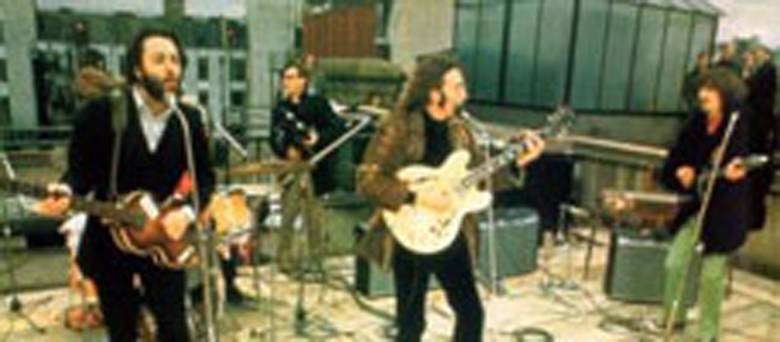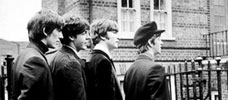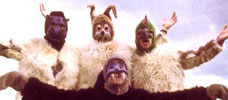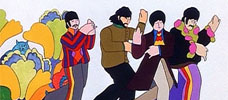Reviews
Michael Lindsay-Hogg
UK, 1970
Credits
Review by Megan Weireter
Posted on 09 September 2009
Source bootleg DVD
Categories The Beatles on Film
On the heels of the over-the-top fantasy of Yellow Submarine, Let It Be comes across as a much colder, more dour film. Its purpose is to be, really, the opposite of Yellow Submarine. The documentary was originally undertaken as a way to show the world how the Beatles rehearsed in preparation for a new live tour—or failing a tour, at least a live performance, a gig planned to be the group’s first since 1966. When even the plans for a live performance collapsed under the weight of the band’s disagreements, the film morphed into the story of the recording of an album. (The rooftop concert that closes the film is the closest thing to a live gig the band managed to commit to, and it comes off here as the act of spontaneity that it was.) Filmed in January of 1969 on the heels of the acrimonious White Album sessions, Let It Be aimed from the start to get viewers as close as the Beatles would let them, stripped of the veneer of fictionalization that hung over A Hard Day’s Night. The idea is that the Beatles are nothing more than musicians, and this is our chance to watch and listen as they make music. And this, it turns out, can be difficult to watch.
But the first problem one encounters with Let It Be is that it still hasn’t had a proper release outside of the cinema. There’s been no DVD release at all, and its availability on video in the early 1980s was so short-lived that you could have blinked and missed it. Nowadays, one is forced to watch it illegally. “Forced” is really the operative word: its long unavailability has given Let It Be an otherwise unearned mystique that assures that Beatles fans will seek it out wherever it can be found. And yet as recently as 2007, Apple Corps head Neil Aspinall claimed that the film was still too controversial for DVD release.
Anyone who’s seen it would have to disagree. Much has been made of the fact that the documentary captures the Beatles as they’re in the process of breaking up—that they bicker and act coldly to each other, all in all in an un-Beatle-like manner. Though this is true to some extent, the story of the Beatles’ breakup has been told so many times by so many sources that nothing that happens in the movie is surprising at all by now. (It’s a story so well-known that it’s been parodied by everyone from the Rutles to the Power Puff Girls.) In fact, if you’ve heard that Let It Be is rough but have never seen it, you’re almost surprised when you realize it’s not as bad as you expected. But even in 2009, apparently, the myth of the Beatles, begun by A Hard Day’s Night and perpetuated by almost every film and album that came after, is so strong that we are told that we’re still not ready to see the Beatles as flawed human beings who might not like each other that much.
But showing the Beatles’ flaws wasn’t the point anyway—at least I don’t think it was, or if it became a goal as the project developed, it was likely an afterthought. More than in any other of the Beatles’ movies, the purpose of Let It Be’s existence is to allow us to hear the Beatles create music. Director Michael Lindsay-Hogg - who had directed the band before in promotional films for songs such as “Paperback Writer” and “Hey Jude” - films the Beatles playing, singing, and talking about playing and singing, and doing very little else. He seems obsessed with chronicling the progression of the music and leaving the detritus of the personalities themselves out of the film as much as he can. It’s hard to say whether this is a conscious choice and an earnest attempt to get to the heart of the Beatles as musicians rather than actors or cartoons, or whether it’s simply because during these sessions the Beatles were at their least charismatic. I suspect there’s a bit of both going on.
As it turns out, this might not have been the best session for movie viewers to have sat in on—not only because Beatle fatigue was showing, but because the music being made just isn’t the greatest of the Beatles’ career. Filming began so closely on the heels of the gigantic White Album that the band was short of songs, for one thing. Paul, who was the prime pusher of the idea to do a live gig, thought it would be good for them to work on some old covers from back when they played clubs, before they hit the big time; once the live performance idea was abandoned, they stuck with the idea of making an album that might feature some covers and some other back-to-basics numbers, to be called Get Back after a song that Paul was working on.
But as far as a viewer of Let It Be can tell, they never actually decided which covers might be good album tracks. We see the band playing around with some oldies like “Shake Rattle and Roll” and “Besame Mucho,” but they seem to be going through the motions. Aimless jams like “Dig It” and “Suzy Parker” get time as well. When the Beatles do work on their original songs, Lindsay-Hogg doesn’t show enough of most of them for us to get any real insight into the creative process. Though we get a couple versions each of “Two of Us” and “I Me Mine,” so we can at last hear how songs have evolved, other songs, like “Across the Universe,” are presented briefly and just as soon forgotten, while others, like “Let It Be,” are performed as essentially finished songs without our ever having seen their evolution. In a way, that’s okay—“Across the Universe,” for instance, was basically abandoned during these sessions, because John was never happy with the arrangement. 1 But since Lindsay-Hogg insists on such an objective perspective, we never learn this information in the film. And so it just looks like a tantalizing thread that goes nowhere.
Lindsay-Hogg’s commitment to objectivity and truth-telling has its limits, though, which might be why the group’s most bitter fighting didn’t make it into the film. Editing weeks of footage into a feature-length film meant that it was easy to edit out the worst stuff, including the moment early on when George actually got so fed up that he quit the band. The others went on recording without him (as they had done a previous time during the White Album sessions when Ringo had quit), but there’s no footage in the film that makes it clear that George isn’t there. When they were finally able to talk him into coming back, on they went. The omission of any indication that George ever left might seem like a huge omission, perhaps even a whitewashing. But I also wonder if Lindsay-Hogg is just so myopically focused on the musical progress that he skips over this because it wouldn’t seem important in the scheme of the film.
The problem is that by the time of Let It Be, it’s too late for us not to care about the Beatles as people. Whether or not we know them as well as we think we do - and of course we don’t at all - they are people who matter to us. This is why, I think, most viewers come away from Let It Be not talking about the songs so much, but about how the Beatles behave, even though the film does its best to elide over all the bad behavior. To show the Beatles interacting nastily with no context or story to hang it together makes it seem that much more jarring; it seems to come out of nowhere. The few moments in which the Beatles show their old personality are the ones that stick with you—John and Yoko waltzing to “I Me Mine,” or Ringo indulging little Heather See2 when she tentatively taps on his drums, for instance.
What the movie needs is something to capture both that affability that fans crave and the music that everyone wants to hear. Hence, the rooftop concert, which makes up almost the last whole third of the movie. An impromptu concert on the roof of the Apple Corps building (3 Savile Row in the Mayfair area of London) ended up being a compromise between Paul, who desperately wanted to perform live again, and George, who did not. (John and Ringo seem to have been fairly ambivalent.) They were also urged to do the concert by Lindsay-Hogg, who realized that his film would need some kind of musical climax to build up to. In the end, everyone agreed to trudge up to the roof and just start playing. The date was Thursday, January 30, 1969, and it was bitterly cold. But when the music started, people started pouring out of the local office buildings to listen.
It’s here that, finally, Let It Be lives up to its promise. The Beatles are performing live again, without the trappings of Beatlemania and without any screams to overwhelm the sound. And it’s fabulous. As in any live performance, particularly by a rusty live band, there are mistakes. The best one is the false start on “Dig a Pony,” in which Ringo has to stop the others to put out his cigarette—it’s a charming error that was left in on the album. Elsewhere, John forgets lyrics to “Don’t Let Me Down” and replaces them with nonsense syllables. But as they play together, you can actually hear the sound gelling and witness the band finding their way again together. All of them, even George, seem to enjoy themselves more and more as they make their way through the set. Most of the people who are interviewed on the street are having a fantastic time, and those who harumph about a rock concert’s proper time and place are exactly the kind of squares whom the Beatles would have had a great time irritating as far back as A Hard Day’s Night as well. In fact, as the police enter the Apple Corps building and shut down the show - due to violation of noise ordinances - it’s reminiscent of the old man kicking the Beatles off his field back in A Hard Day’s Night’s “Can’t Buy Me Love” scene. It’s one small way in which nothing has changed.
But ultimately it proved illusory. The Let It Be project languished, and didn’t get a theatrical release until almost a year and a half later, in May of 1970. By then, Paul had officially announced the Beatles’ breakup, and the band had descended into the public bickering that would go on throughout the ’70s. They would never play together again. And so Let It Be shows us, in the rooftop concert, one last glimpse of what made the Beatles so special, what made them mean more than any other band of their era or, arguably, any era. In an otherwise cold, clinical film, it’s a glimmer of hope.
- The version of “Across the Universe” on the Let It Be album is actually an earlier recording that dates to February of 1968; the arrangements they were playing with in this 1969 session never went anywhere. Phil Spector, who ended up producing the album, added the string and choral overdubs that he was famous for to the earlier track mainly just to flesh out the album with songs that had appeared in the movie.↩
- Paul’s girlfriend Linda Eastman’s daughter, whom Paul would later adopt.↩
More The Beatles on Film
We don’t do comments anymore, but you may contact us here or find us on Twitter or Facebook.








